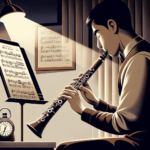Mastering Sight-Reading on Your Martin Freres Clarinet
Sight-reading can feel like a tricky puzzle for many clarinetists. It's one of those skills that can make you sweat a little, right? Well, take a deep breath and relax! With the right strategies and a pinch of practice, you can improve your sight-reading skills, especially when you are working with a Martin Freres clarinet.
The Basics of Sight-Reading
Let's start with the fundamentals. When looking at sheet music, your goal is to understand what you see quickly. It's similar to reading a book – the more you read, the faster you become. Begin with simple pieces. Don't try to tackle difficult music right away, or you might struggle. Choose music that's slightly easier than your current skill level to build confidence.
Understanding Rhythm
Now, here's the fun part—understanding rhythm! Rhythmic accuracy is important for every musician, not just drummers. As a clarinet player, you need to feel those beats. Use a metronome to keep your timing steady. You could even clap the rhythms before playing them. It's surprising how helpful this can be! When you sit down with your Martin Freres clarinet, your solid rhythm foundation will really come through.
| Rhythm Practice Techniques | Benefits |
|---|---|
| Using a metronome | Improves timing accuracy |
| Clapping rhythms | Enhances rhythm internalization |
| Counting out loud | Strengthens beat awareness |
Recognizing Patterns
Next, let's talk about patterns! Music often repeats itself. Once you start noticing these patterns, your reading speed will improve dramatically! Practice scales, intervals, and arpeggios regularly to get familiar with the notes and fingerings. Regular practice makes this familiarity automatic. You'll be able to read new music more easily, and your fluency will increase.
Looking Ahead
Here's a useful tip: always look ahead! When you're reading music, try to glance a couple of measures in advance. This prepares your brain and gives your fingers a head start. It's like staying a step ahead in a race!
Practice Sight-Singing
Another great technique is to practice sight-singing. Yes, you heard that right! Singing the notes out loud helps reinforce pitch recognition. It also keeps you connected to tunes and melodies. You can do this even before picking up your Martin Freres clarinet. Try to hear the melody in your head, then play it. Trust me; it's worth the effort!
Practice with a Friend
Consider practicing sight-reading with a buddy. Sometimes two heads are better than one! Take turns playing duets, or even sight-read the same piece to compare notes. You can learn a lot from another person's perspective. Plus, it's much more enjoyable to make music together.
Dynamic Interpretation
Let's not forget about dynamic interpretation. Sight-reading isn't just about playing the correct notes. It's about performing with expression and style. As you get more comfortable, try adding dynamics, articulations, and nuances to your performance. Experiment! See what fits the piece. Thinking about how you should sound will help bring the music to life.
Analyze Before Playing
Before starting a new piece, take a moment to analyze it! Look for the key signature, time signature, and tricky sections. Mark any challenging parts you need to pay extra attention to. This preparation can save you a lot of trouble when performing.
Instrument Care
Lastly, don't forget about your instrument! The sound quality and performance of your Martin Freres clarinet will influence how you hear and interact with the music. Good instruments provide better tone and response, which can make your sight-reading practice more enjoyable. Always keep your instrument clean and well-maintained. It's like a car; it needs care to perform its best!
Conclusion
So, are you ready to improve your sight-reading skills? Don't worry too much. With practice, smart learning strategies, and your reliable Martin Freres clarinet, you'll be reading sheet music confidently in no time! Happy playing!







